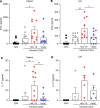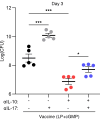IL-10 inhibition during immunization improves vaccine-induced protection against Staphylococcus aureus infection
- PMID: 38973612
- PMCID: PMC11383370
- DOI: 10.1172/jci.insight.178216
IL-10 inhibition during immunization improves vaccine-induced protection against Staphylococcus aureus infection
Abstract
Staphylococcus aureus is a major human pathogen. An effective anti-S. aureus vaccine remains elusive as the correlates of protection are ill-defined. Targeting specific T cell populations is an important strategy for improving anti-S. aureus vaccine efficacy. Potential bottlenecks that remain are S. aureus-induced immunosuppression and the impact this might have on vaccine-induced immunity. S. aureus induces IL-10, which impedes effector T cell responses, facilitating persistence during both colonization and infection. Thus, it was hypothesized that transient targeting of IL-10 might represent an innovative way to improve vaccine efficacy. In this study, IL-10 expression was elevated in the nares of persistent carriers of S. aureus, and this was associated with reduced systemic S. aureus-specific Th1 responses. This suggests that systemic responses are remodeled because of commensal exposure to S. aureus, which negatively implicates vaccine function. To provide proof of concept that targeting immunosuppressive responses during immunization may be a useful approach to improve vaccine efficacy, we immunized mice with T cell-activating vaccines in combination with IL-10-neutralizing antibodies. Blocking IL-10 during vaccination enhanced effector T cell responses and improved bacterial clearance during subsequent systemic and subcutaneous infection. Taken together, these results reveal a potentially novel strategy for improving anti-S. aureus vaccine efficacy.
Keywords: Bacterial infections; Bacterial vaccines; Immunology; T cells; Vaccines.
Conflict of interest statement
Figures









Similar articles
-
One Dose of Staphylococcus aureus 4C-Staph Vaccine Formulated with a Novel TLR7-Dependent Adjuvant Rapidly Protects Mice through Antibodies, Effector CD4+ T Cells, and IL-17A.PLoS One. 2016 Jan 26;11(1):e0147767. doi: 10.1371/journal.pone.0147767. eCollection 2016. PLoS One. 2016. PMID: 26812180 Free PMC article.
-
Protection against Staphylococcus aureus Colonization and Infection by B- and T-Cell-Mediated Mechanisms.mBio. 2018 Oct 16;9(5):e01949-18. doi: 10.1128/mBio.01949-18. mBio. 2018. PMID: 30327437 Free PMC article.
-
Active Immunization with Extracellular Vesicles Derived from Staphylococcus aureus Effectively Protects against Staphylococcal Lung Infections, Mainly via Th1 Cell-Mediated Immunity.PLoS One. 2015 Sep 2;10(9):e0136021. doi: 10.1371/journal.pone.0136021. eCollection 2015. PLoS One. 2015. PMID: 26333035 Free PMC article.
-
Considering the 'Alternatives' for Next-Generation Anti-Staphylococcus aureus Vaccine Development.Trends Mol Med. 2019 Mar;25(3):171-184. doi: 10.1016/j.molmed.2018.12.010. Epub 2019 Jan 31. Trends Mol Med. 2019. PMID: 30713007 Review.
-
Is there a future for a Staphylococcus aureus vaccine?Vaccine. 2012 Apr 19;30(19):2921-7. doi: 10.1016/j.vaccine.2011.11.006. Epub 2011 Nov 21. Vaccine. 2012. PMID: 22115633 Review.
Cited by
-
Acellular Pertussis Vaccines Induce CD8+ and CD4+ Regulatory T Cells That Suppress Protective Tissue-Resident Memory CD4+ T Cells, in Part via IL-10.Eur J Immunol. 2025 Jul;55(7):e51630. doi: 10.1002/eji.202451630. Eur J Immunol. 2025. PMID: 40629997 Free PMC article.
-
Immunological Responses to Tetanus and Influenza Vaccination in Donkeys.J Vet Intern Med. 2025 Jul-Aug;39(4):e70137. doi: 10.1111/jvim.70137. J Vet Intern Med. 2025. PMID: 40413721 Free PMC article.
-
Pathobiont-induced suppressive immune imprints thwart T cell vaccine responses.Nat Commun. 2024 Dec 16;15(1):10335. doi: 10.1038/s41467-024-54644-w. Nat Commun. 2024. PMID: 39681568 Free PMC article.
-
Staphylococcus aureus in Inflammation and Pain: Update on Pathologic Mechanisms.Pathogens. 2025 Feb 12;14(2):185. doi: 10.3390/pathogens14020185. Pathogens. 2025. PMID: 40005560 Free PMC article. Review.
References
MeSH terms
Substances
Grants and funding
LinkOut - more resources
Full Text Sources
Medical

